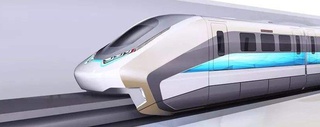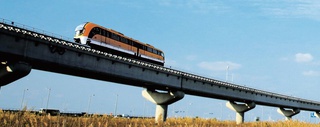World's fastest high-speed trains in commercial operation in 2021
The world has changed a lot since the introduction of the first high-speed rail in Japan on the Tōkaidō Shinkansen line in 1964. The 0 Series Shinkansen had an initial top speed of 210 km/h (130.5 mph). There are now 26 countries with high-speed rail networks, and many more are planning to have one in the near future. In this list, you will find the record speed of commercial operation in each country with the exception of China where it's important to highlight two very different technologies. This article is fact-checked and it will be updated if there will be any changes in the future.
12. Greece - Frecciargento class ETR 485 - 200 km/h (124.3 mph)
Greece has recently entered the high-speed rail club by introducing the ETR 485 (upgraded ETR 480) trains for testing purposes and purchasing the ETR 470 tilting trains produced by Fiat Ferroviaria. As a result, the Athens to Thessaloniki line has been shortened to less than 4 hours by these new "Silver Arrow" trains. By the end of this year, the trip will only take 3 hours and 20 minutes after completing the upgrading and electrification work on the 502 km Athens - Thessaloniki corridor.

12. Poland - Pendolino ED250 - 200 km/h (124.3 mph)
There have been plans to buy Pendolino trains in Poland since the end of the '90s. The Polish railway company, PKP, signed the contract for 20 Pendolinos ETR 610 in 2011 and received the first batch in 2013. In November 2013, on the Central Rail Line of Poland, the Pendolino reached 293 km/h (182 mph) during one of the final test runs.
There are currently regulatory issues and the installation of the ETCS (European Train Control System) Level 2 signaling system. The current speed limit of 200 km/h will be lifted, and Pendolinos will be able to reach their official top speed of 250 km/h as early as the end of 2023.

11. Sweden - X2, X3, X50, X52, X54, X55, X74 - 205 km/h (127.4 mph)
Sweden has an extensive network of railways and a long history dating back to 1849 when the first line was opened in Värmland. Their railway network is adding up to a whopping 12,821 km (7967 miles). SJ, the government-owned passenger train operator, has a fleet of trains capable of 200 km/h. The most notable is Regina, which is a Swedish electric passenger train manufactured by Bombardier Transportation. During the "green train" project, a modified X52 train broke the Swedish rail-speed record of 303 km/h (188 mph) on 14 September 2008. The quirky reason for Sweden having 205 km/h as maximum commercial speed is that if the trains are late, they are allowed to increase their speed from 200 km/h to 205 km/h to make up for the lost time.

10. Norway - BM71 Flytoget, NSB Class 73 - 210 km/h (130.5 mph)
Norway's only high-speed rail opened in 1998 that operates on a 64 km (40 miles) section between Oslo Central Station and Eidsvoll via Oslo Airport called the Gardermoen Line. The GMB Class 71 and the NSB Class 73 electric trains built by Adtranz Strømmen both support speeds of up to 210 km/h.

9. Finland - Alstom Sm3, Sm6 - 220 km/h (136.7 mph)
The Lahden oikorata railway line connects the towns of Kerava and Lahti, and it is at present the only high-speed rail in Finland. Allegro, the high-speed train service, is operating Alstom VR Class Sm3/Sm6 trains. The Kerava to Lahti is the high-speed part on the way to St. Petersburg from Helsinki. This is the section where the Sm3/Sm6 trains can reach their top speed of 220 km/h, reducing the total journey time between the Finnish capital and St. Petersburg to only 3 hours and 27 minutes.

9. Portugal - Alfa Pendular - 220 km/h (136.7 mph)
From Porto to the southernmost Algarve region at the coast, the North of Portugal is being served by Pendolino high-speed tilting trains called the Alfa Pendular since the '90s. As a result, Porto can be reached from Lisbon in 2 hours 35 minutes.

8. Austria - Viaggio Comfort - 230 km/h (142.9 mph)
ÖBB's high-speed train, the Railjet, travels at speeds of up to 230 km/h between Vienna and St Pölten on the West Line. The design allows 250km/h operation in the future. This is part of the Magistrale for Europe corridor that intends to connect Paris and Bratislava with a link to Budapest by high-speed railway.

8. Uzbekistan - Talgo 250 - 230 km/h (142.9 mph)
Uzbekistan has an extensive, 600 km (373 miles) long high-speed rail network, which uses the excellent Talgo 250 trains that can attain 250 km/h top speed if the infrastructure is fit for it. In Uzbekistan, it's limited to 230 km/h at the moment. The HSR network of Uzbekistan is branded with the exotic-sounding "Afrosiyob" name.

7. USA - Amtrak Acela Express - 241 km/h (150 mph)
In the United States, despite the early start in the high-speed rail game - the Metroliner service in 1969 – and many proposals, the country is still mainly in the phase of planning. Amtrak's Acela Express has a 54.6 km (33.9 miles) section where this flagship service attains its top speed of 241 km/h. The soon to be under construction high-speed network between Houston and Dallas by Texas Rail has a design speed of 205 mph (330 km/h), and the international version of the N700-I Series Shinkansen trains are on order. Service is scheduled to start in 2026, and it will cover the distance between Houston to Dallas in under 90 minutes.

6. Hong Kong - Vibrant Express - 250 km/h (155.3 mph)
The Vibrant Express is a sight to behold. This cleverly branded MTR380A train by CRRC (the Chinese rolling stock manufacturer) looks more capable than the numbers indicate. It is indeed the case. They could operate at the maximum speed of 380 km/h (236.1 mph), but the pace is limited to 250 km/h between Futian and West Kowloon in Hong Kong.

6. Switzerland - Pendolino Astoro - 250 km/h (155.3 mph)
Switzerland has possibly the most demanding terrain in Europe when it comes to constructing infrastructure, and for a long time, this country was known for punctual train service, but not for high speeds. However, this has changed since purchasing the modern Pendolino Astoro train sets and the construction of the Lötschberg Base Tunnel, where Pendolinos reach their top speed of 250 km/h.

6. Russia - Peregrine Falcon - 250 km/h (155.3 mph)
Russia has been experimenting with high-speed rail since the 70's with their Russkaya Troika, but it was only in 2009 when they made a significant breakthrough. They opened the Moscow to Saint Petersburg high-speed rail served by the Sapsan trains (Siemens Velaro). The 2030 plan includes rapid trains connecting Moscow with Nizhniy Novgorod, Kazan, Samara, Perm, Ufa, Ekaterinburg, Voronezh, Rostov-na-Donu, and Tuapse.

6. Turkey - TCDD HT80000 - 250 km/h (155.3 mph)
Turkey has bet big on its high-speed rail network. At present, they have a 745 km (463 miles) long network, additionally Ankara – Izmir, Ankara – Siva, and Osmaneli - Bursa lines are under development. The Turkish State Railways operates TCDD HT65000 (CAF) and TCDD HT80000 (Siemens) train sets on these lines. Siemens Velaro trains have a top speed of 300 km/h, allowing for a potential speed increase on modernized tracks in Turkey.

5. Netherlands - Thalys, ICE, Eurostar - 300 km/h (186.4 mph)
Three high-speed rail services are operated in the Netherlands: Thalys, InterCityExpress (ICE), and Eurostar. Most of the way between Antwerp and Rotterdam, Rotterdam and Amsterdam allow for 300 km/h. This high-speed railway line is called the HSL-Zuid, which is on the corridor that connects Amsterdam/Schiphol International Airport with Paris and Lille via Brussels.

5. Saudi Arabia - Talgo 350 SRO - 300 km/h (186.4 mph)
The Haramain high-speed railway was opened to the public in 2018. The oil-rich country has linked the two Islamic holy cities, Mecca and Medina, with high-speed rail service using a 453 km (281.5 miles) long track. The 36 Spanish Talgo 350 SRO trains can reach speeds of up to 300 km/h, reaching Mecca from Medina in just 2 hours.

5. Germany - ICE 3 - 300 km/h (186.4 mph)
Undoubtedly, Germany is expected to be higher on this list as the manufacturer of trains capable of incredible speeds. Still, it seems that regulations so far have not authorized speeds beyond 300 km/h, and sadly no maglev line is in commercial operation. What is impressive, however, is the large-scale network of high-speed rail they operate. München (via Nürnberg and Erfurt) to Leipzig and Frankfurt to Köln accommodates tracks for 300 km/h with many more cities connected by 200/250 km/h speeds. The third generation of ICE trains have a service speed of 330 km/h (205 mph) while the German-made Transrapid maglev trains can reach speeds of up to 550 km/h (340 mph) – but they are limited to 431 km/h (268 mph) on the Shanghai Transrapid track.

5. Italy - Frecciarossa 1000, Italo ETR 575 - 300 km/h (186.4 mph)
Italy has 64 million passengers annually on the high-speed rail services two companies provide: Trenitalia and NTV. Two lines connect the major cities of Italy with a total network length of 974 km (605 miles). Milan to Bologna takes, for example, only 53 minutes. The Frecciarossa 1000, also known as the ETR 400/1000, that entered operation in 2015, is their iconic high-speed train designed to achieve speeds of up to 400 km/h (248.5 mph). This model has replaced on many routes the previous fastest train, the ETR 500 "Frecciarossa". The other Italian train that goes 300 km/h in commercial operation is the futuristic AGV 575, with a theoretical top speed of 360 km/h (223.7 mph).

5. Belgium - Thalys TGV - 300 km/h (186.4 mph)
The Belgian rapid rail network has five parts: HSL1, HSL2, HSL3, HSL4, and the HSL-Zuid. These lines enable the high-speed connection of the major Belgian cities: Brussels, Liege, Antwerp, and making Belgium a corridor to pass from France (and the United Kingdom) to Germany and the Netherlands since 1995. The French Thalys PBA and PBKA TGV trains and the Eurostar e320 trains can go as fast as 300 km/h.

5. Taiwan - THSR 700T - 300 km/h (186.4 mph)
Taiwan High-Speed Rail (THSR) links the Northern parts of the country with the South. The trains are going from the capital Taipei to the southern city of Kaohsiung on a 350 km (217 miles) long line. The THSR started operating in 2007 using the THSR 700T high-speed electric multiple unit trainsets based on the Japanese 700 Series Shinkansen trains. The high-speed rail in Taiwan has a unique system called the DWS (Disaster Warning Systems) due to the country's high risk of natural disasters.

5. Spain - AVE Class 100, 102, 103, 112 - 300 km/h (186.4 mph)
The high-speed rail service in Spain operated by Renfe is called the Alta Velocidad Española (AVE). To this date, Spain has built a spectacular 3,100 km (1,926 miles) long network of high-speed railways in a country with a population of only 47 million. This network is being extended to the North, to the border with Portugal, and in the South to connect the cities of Granada, Almeria, Murcia, Alicante, and Valencia. Little known that the top speed used to be 310 km/h in Spain between 2011 and 2016, the limit is back to 300 km/h.

4. South Korea - KTX I / KTX-Sancheon - 305 km/h (189.5 mph)
The Korea Train eXpress (KTX) uses KTX-1 and KTX-Sancheon trains that were designed and built locally. The service was launched on the high-speed line from Seoul to Busan in 2004. The maximum speed for trains in regular service is 305 km/h, although the infrastructure is designed for 350 km/h. The KTX-Sancheon is so quick it can accelerate from 0 to 300 km/h in 316 seconds. The KTX-III, the commercial derivative of the HEMU-430X experimental high-speed train, is intended to connect Seoul with Busan in 1 hour 50 minutes with a targeted top speed of 370 km/h (230 mph). This would make it the world's fastest commercial train in the world.

3. United Kingdom - Eurostar e320 - 320 km/h (198.8 mph)
In the United Kingdom, railway experts are busy designing and preparing the first phase of the new purpose-built high-speed network called the HS2 (High Speed 2). This project will significantly improve travel times, as the proposed operating speed will be 330 km/h (205 mph) compared to the current top speed of 125 mph (200 km/h). The only exception now is the Eurostar route that takes passengers from London to Brussels via Paris at speeds of 320 km/h.

3. Morocco – Al Boraq - 320 km/h (198.8 mph)
It might come as a surprise to some that the North-African country, famous for its architecture, beautiful landscape, and food, has joined the exclusive club of the top 3 fastest commercial trains in the world. The Al Boraq is a 323 km (201 miles) long high-speed rail service between Casablanca and Tangier opened just recently in 2018. Al Boraq is a mythical creature that transported the Islamic prophets, similar to the centaur in Greek mythology. The Moroccan national railway company ONCF operates modern Alstom RGV2N2 train sets. There is a future extension plan that would connect Casablance with Marrakech onwards to Agadir.

3. France – TGV - 320 km/h (198.8 mph)
As we all know from the Taxi movie by Luc Besson, the only thing quicker than the French TGV is a heavily modified white Peugeot 406. The TGV is so quick that it still holds the world record for the fastest test train in the world. It reached an insane 574.8 km/h (357.2 mph) on 3 April 2007. There are seven types of TGV trains: SNCF TGV Atlantique, SNCF TGV Réseau, SNCF TGV Duplex, Euroduplex, SNCF TGV POS, Eurostar, and Thalys. It might come as no surprise that all of these trains can easily go at least 300 km/h (186.4 mph).
Image: France TGV 4402 high-speed train reaching 574 kph (357 mph) on 3 April 2007 near Le Chemin

3. Japan - E5, E6, H5 Series Shinkansen - 320 km/h (198.8 mph)
Japan is the cradle of high-speed trains. The Shinkansen brand is world known, and it comes as no surprise that they produce and operate some of the fastest trains in the world. The E5, E6, and H5 series are all easily capable of maintaining the 320 km/h (198.8 mph) top speed, and if regulations were not as strict as they are in Japan, they could be even quicker. Tests have shown that hitting 443 km/h (275 mph) is no big feat for the Shinkansens. However, over 50 years of perfect safety records are not something they are willing to risk.

2. China - CR400AF / CR400BF - 350 km/h (217.5 mph)
China's staggering high-speed rail development can be summed up by a single fact. Over two-thirds of all the high-speed rails in the world are located in China. They have a 29,000 km (18,000 miles) long high-speed rail network with thousands of kilometers of additional lines under construction. Moreover, they have a collection of high-speed trains, the most notable being the Fuxing train series developed by CRRC. The "Blue/Red Dolphin" - CR400AF and the "Golden Phoenix" – CR400BF are the world's fastest conventional high-speed trains in regular service at the moment. Their top speed during testing is even more impressive: 494 km/h (307 mph). If regulations allow, these trains might be the first to hit 400 km/h (249 mph) in commercial service.

1. China - Shanghai Transrapid - 431 km/h (268 mph)
Launched in 2004, the Shanghai Transrapid is the only high-speed maglev to date, yet it's the fastest commercially operated train in the world. As the track is only 30.5 km (18.95 mi) long, the travel time is a mere 7 minutes. The German technology comes from Transrapid, which developed the high-speed monorail train using magnetic levitation. This record is not expected to last long, as SCMaglev is to be introduced in 2027 on the Tokyo – Nagoya line, and the Chinese high-speed maglev system is well under development.
Image by Max Talbot-Minkin





